Fred Milson: developing the practice of youth and community work. Fred Milson (1912-1983) was an influential writer and trainer who did much to develop youth and community work practice within the Methodist church and the Youth Service generally. He was also an important contributor to national policy debates. Here we assess his contribution.
contents: introduction · social group work and christian education · youth and community · the development of training and professionalization · political education · conclusion · further reading and references · links · how to cite this article
Opening picture: Clubland, Wandsworth – one of the best-known Methodist youth projects.
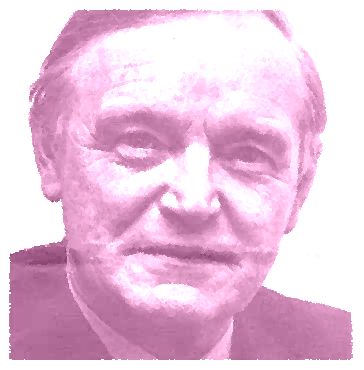
Life
We know from his death certificate that Frederick William Milson was born in Sheffield on Christmas Day, 1912. There is just one record of birth from around this period with this name or variations of it. His father (also Frederick William) was a newsagent, his mother was Ada Annie Milson (formerly Revill). They had married in 1909 in the Holy Trinity Church, Wicker Lane, Sheffield. A couple of years later, they had a daughter – Florence Marjorie – and Frederick followed just over a year later (in 1912). Sadly, within three years the children’s father had died at the family home/newsagents (120 Wicker, Sheffield) (Yorkshire Telegraph and Star 29/09/1915). The next we hear of the children is in 1921. Ada – their mother – had remarried and was now living in Ripley, Derbyshire with her new husband Joseph Radford, his children, and Frederick. Joseph is described as a grocer and general dealer. Frederick’s sister Florence had stayed in Sheffield at 120 Wicker. She was living with her grandmother who was still running the business (1921 Census).
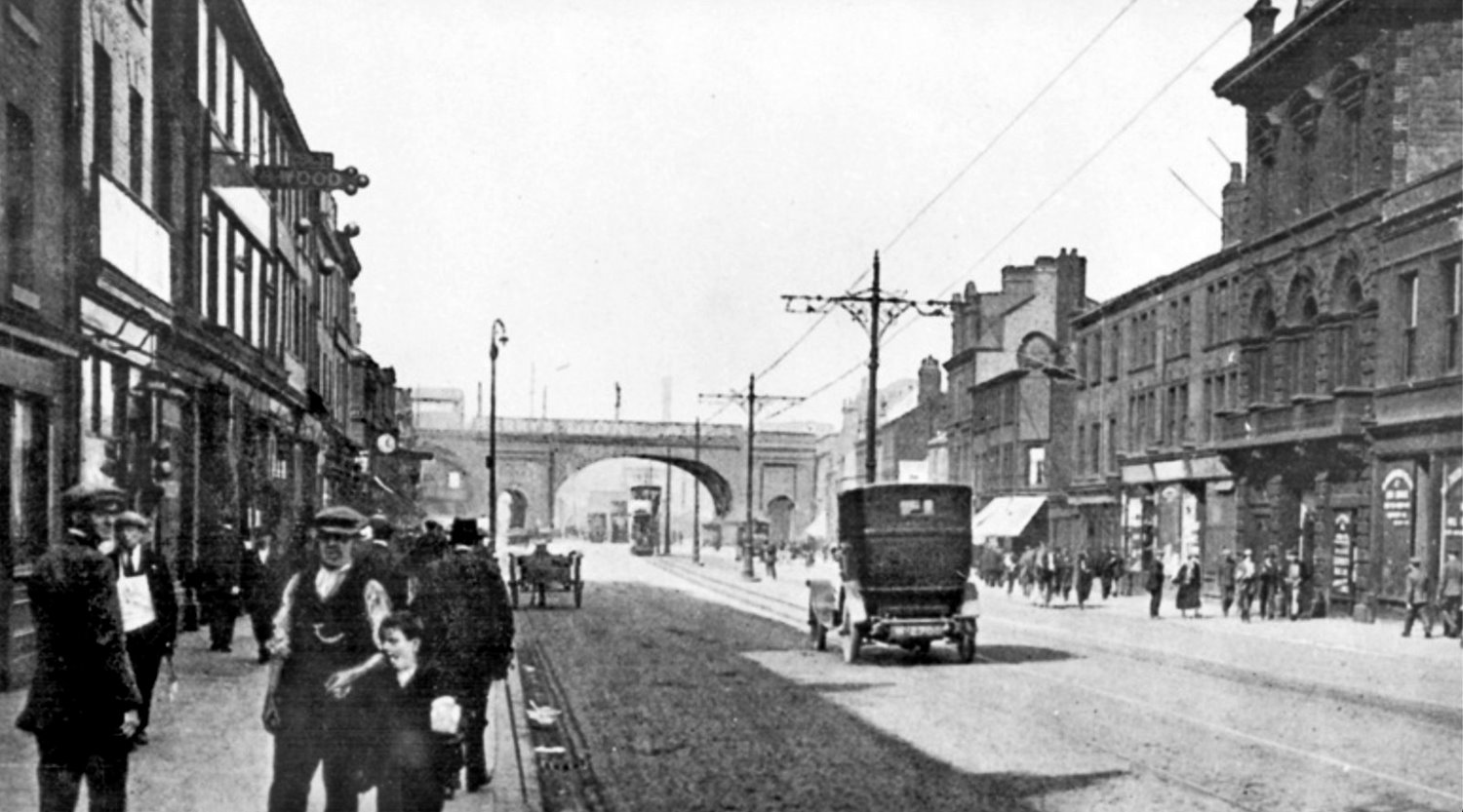
At this point, we have very little information about Fred Milson’s schooling or how he became a Methodist, but we do know he was to attend one of the four colleges that formed the Wesleyan Theological Institution (see Methodist Council 2010). Based in Headingley it provided initial training that enabled Frederick to join the ministry. In 1939 he married Joyce B. Haggerjudd (1917-2011) and in the 1939 Register they are listed as living in Station Road, West Drayton, West London (not far from Heathrow Airfield as it was then). Fred was working as a Methodist Minister by this point. Later, in the 1940s, he became a minister in Hull (at Kings Hall). Joyce and Fred were to have two children – Andrew and Celia (born in 1945). Whilst in Hull Fred also studied for, and gained, a Batchelor of Divinity (being the first student from the University of Hull to do so – The Daily Mail [Hull] 22/08/1950).
In September 1950, Milson became the Superintendent of Longton Central Mission, Stoke-on-Trent (now known as Longton Central Hall). Whilst there he made use of the large building to organize several exhibitions on themes such as ‘What the Church is doing’ and ‘Church and Community’. The former attracted over 10,000 visitors (Staffordshire Sentinel 14/02/1952). From there he moved in the summer of 1954 as a supernumerary minister to take up a post as a youth tutor in Birmingham. Within a year, however, he had accepted an invitation to become minister of the Brunswick Methodist Church in Leeds. Brunswick was well-known in Methodist circles as the former home of two key preachers – Dr. Leslie Weatherhead and Dr. W. E. Sangster. Milson also became the Methodist Chaplain to Leeds University (Staffordshire Sentinel 5/05/1955). We heard from a reader, that during his time at Brunswick Methodist Church Fred had given members of their family, ‘very wise counsel and showed great kindness, giving his time to help them think clearly as they dealt with a very difficult situation’.
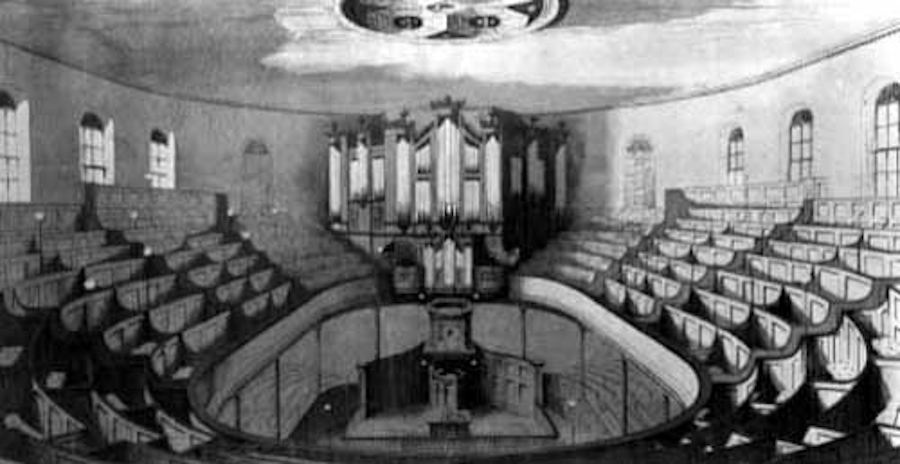
In 1960, Fred Milson joined the staff of Westhill College. The College had begun life in 1907 as something of a Quaker institution concerned with the education of Sunday School teachers. It was established by George Cadbury and an American lumber merchant and advocate of Sunday schools, George Hamilton Archibald. By 1912 it included representatives of the Free Churches on its governing body. Elsewhere on infed.org, we discuss the development of Westhill as a place for the development of missionaries and later teachers (see the article on Basil Yeaxlee). With government recognition of the need to train youth workers during the Second World War, Westhill College developed and ran short courses for youth leaders between 1940 and 1943 and weekend programmes for local leaders from 1943-4. In 1947 a two-year Certificate in Children and Youth Work began (Holmes 2009: 137-8) (see, also Methodism and youth work). From 1951 this programme was endorsed by the University of Birmingham. Many of the other youth work training programmes did not survive. Westhill’s experience, thus, placed them in a good position in 1960 to respond to the Albemarle Report and to develop a course that addressed the contemporary ‘professionalized’ requirements for youth work training. Fred Milson’s appointment as head of the department was part of this process.
Unlike the National College established in Leicester to provide ’emergency’ training to rapidly expand the number of youth workers, Westhill retained a two-year programme (the National College was pegged to one year) and did not seek to recruit huge numbers of students. It also offered a different student experience. The course ran alongside new teacher education programmes and benefitted from new facilities and buildings. Fred Milson’s task was to develop a programme that both addressed contemporary youth work practice and embodied a liberal Christian perspective in line with the ethos of Westhill. Within three years, he was joined by John Parr (1927-2017) – who had trained on the 1949/1950 Westhill programme and was an active Methodist lay preacher. Parr had also worked as a training tutor for the Birmingham Association of Youth Clubs for eight years (Birmingham Mail 20/08/1963) so arrived with strong local knowledge and experience. One of his first tasks was to build a programme for community centre wardens – and this connected with Milson’s experience and interest in community activity. He was later to succeed Fred Milson as Head of the Department (in 1977). Another influential colleague was Inga Bulman (1935-2016) who worked with the staff on Westhill’s B.Ed. programme to develop a youth work option that ‘enabled students to have both qualified teacher status and specialist knowledge of youth and community work (qualifying them as youth and community workers under JNC conditions as teachers, but recognising the separate specialism)’ (Holmes 2009: 141).
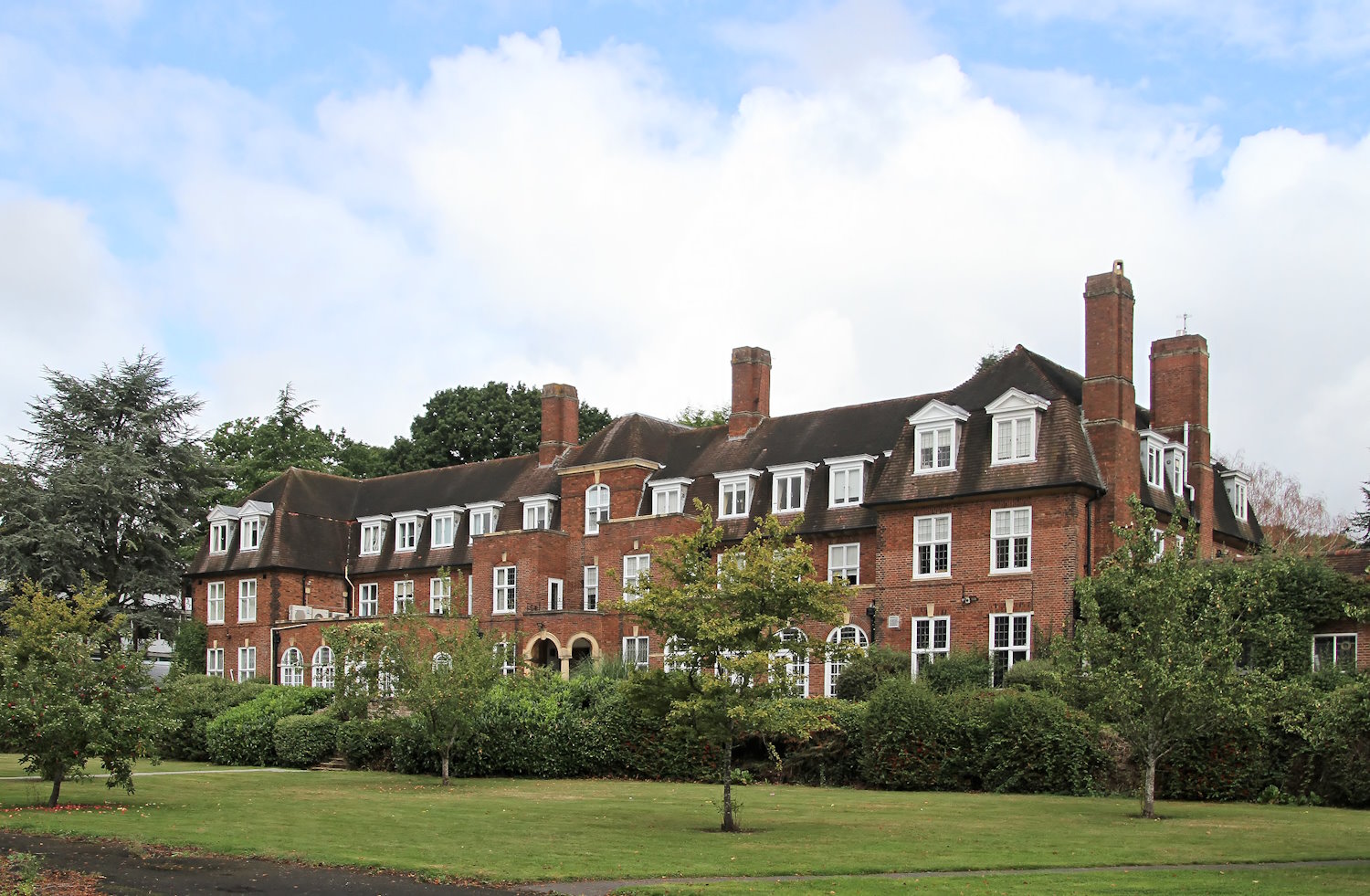
While at Westhill College Milson wrote a significant number of books and pamphlets; spoke at various conferences across England and Wales; continued his involvement with Methodist churches and organizations; and chaired one of the two Committees that produced Youth and Community Work in the 70s (DES 1969). At the same time, he regularly produced articles (both short and long) for the local papers in Birmingham. The Birmingham Post carried nearly 200 articles either written by him or mentioning him, and the Birmingham Mail over 80. He also wrote for youth work publications such as Young People Today, but also – I have been reminded – holds the record as the only person in over 40 years to ask for a fee for submitting an article for Youth and Policy.
Fred and Joyce Milson lived in Hay Green Lane in Bournville and later moved to 1 Kestrel Close – close to the boundary between Selly Oak and Bournville and only a ten-minute walk away from Westhill College. The house was just across the road from another institution established by George Cadbury – Fircroft College of Adult Education which was based in his previous family home. Cadbury had established it ‘to educate his workers so that they could pass on their knowledge to others and is one of only two adult residential colleges in England’ (Fircroft College of Adult Education).
The Milson children had taken their own paths. Andrew had joined the West Yorkshire Constabulary and Celia had gone to Leicester to train as a social worker – and then returned to Birmingham to work as a child care officer with the Corporation’s Social Services Department (Birmingham Evening Mail – September 3, 1983). She had met a computer engineer – Thomas Blaszkowicz – in Leicester and they were married at Selly Oak Methodist Church. Fred Milson officiated at his daughter’s wedding – it had been years since he had last conducted one (Birmingham Mail – June 2, 1971). Celia and Thomas went on to have three children.
Fred Milson remained busy in retirement. For, example, he chaired the National Council for Voluntary Youth Services (NCVYS) for six years (1976-1982). Described as ‘a shrewd, kindly man’, he was, ‘much loved and respected throughout the Youth Service for his uncompromising honesty of purpose combined with a puckish sense of humour’ (Green 1986: 31-2). He died not long after finishing with NCVYS. In Selly Oak Hospital after a mild heart attack, a week later Fred was preparing to go home when he experienced a fatal second attack (Birmingham Evening Mail September 3, 1983). He was 70. Joyce Milson later moved to Fleet in Hampshire and died there in 2011 aged 94. Fleet was where her daughter Celia Blaszkowicz lived. Sadly, Celia was diagnosed with the asbestos-linked lung cancer mesothelioma in 2003 (see her letter to Daily Telegraph (July 6, 2006) and died in 2007.
Social group method and Christian education
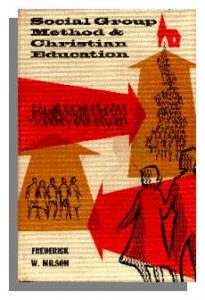
In the cool hour of thought, we all know that the only attributes which count for anything are those which spring from the total life and character. “Be yourself” is the first rule of the youth leader, since he cannot in the end be anyone else, and will quickly be found out if he tries. The most serious defect however in this earlier approach is that it makes success lean too heavily upon the personality and influence of the leader. Social-science-wise, it makes the youth leader into a case-worker rather than a group worker. We do not deny of course that the leader exerts a vital personal influence and interacts with individual members of the group. But in the modern understanding of our craft, he is more concerned with each other… He is not the centre of the message. (Milson 1963: 21)
His book set out the basic assumptions and processes of social group work and argued that effective leadership ‘respects and uses the group process and recognizes the possibility of new life when the individual forsakes his isolation and belongs to a fellowship’ (Milson 1963: 23). At times he emphasizes the worker as a technician (rather than a Messiah) – but he does look to agape and the ‘essential tools of warmth and understanding, faith and caring’ (ibid.: 26).
Today, some of the more interesting elements of the book lie in Fred Milson’s discussion of Christian leadership – especially around the question of whether workers are educators or indoctrinators. Like Barnett, Fred Milson had a particular grasp on how a concern with evangelism could be partnered with youth work (and in this case social group work). He cautioned against approaching young people ‘in a mood of spiritual scalp-hunting’ or looking upon them as ‘promising pew fodder’. In contrast, he looked at how, as educators, workers lived with ‘a dual loyalty’ – respecting the Gospel and respecting the integrity of the people among which they work – and that in the example of Jesus they could find a way forward.
Those with the gift of faith may learn that the method is part of the Kingdom which He came to proclaim. It is compounded of trust in the power of God at work in the world – and to be relied upon – and of confidence in the dignity of men attacked but not destroyed by sin – and never to be denied. Doubtless the victory which Jesus won in the wilderness at the Temptations, extended to His training of the Twelve. They were not to be bribed, bullied or dazzled. (Milson 1963: 146)
In this way, Fred Milson sought to connect current thinking in youth work, link it up to an important tradition of practice, and place it within a particular, Christian, orientation.
Youth and community
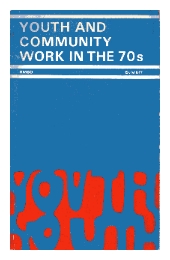
In a similar vein, Milson was able to tap into the 1960s policy concerns around community and community work. During the first half of the 1970s, he wrote several books on community work (1970b, 1973 and 1975) however, it was the way he looked to youth in the context of community that will be remembered. This found its major expression in the Youth Service Development Council (1969) report Youth and Community Work in the 70s. The report was part of a rather ill-focused review of youth work developments after the Albemarle Report (Ministry of Education 1960) (see Davies 1999). It sprang from the work of two sub-committees (there were going to be more) – one chaired by Andrew Fairbairn – examined youth work and schooling and further education; the other – chaired by Fred Milson – youth work and the relationship with the ‘adult community’. As Davies (1999) and Holmes (2001) have reported, there was considerable tension between the two committees around the future role of the youth service. The former committee, and in particular its chair, wanted to locate youth work far more fully within schools – especially community schools. Milson and his colleagues were sceptical of the extent to which community schools could represent the full range of community interests (Holmes 2001: 225). The result was a strange document that contradicted itself in places and bore all the marks of political (or administrative compromise (Davis 1999: 124-8). However, it did have an explicit position around the sort of society that should be aimed at. Drawing on Amitai Etzioni’s (1968) communitarian vision they argued for ‘The Active Society’.
‘The Active Society’ is the best short description we can think of to describe our commitment and in support of our contention we start with a belief, relevant to all educational and social welfare provision, which rests on the twin bases of our view of present day society and the development of personality.
In a country such as ours, subject to the changes consequent upon a rapidly changing technology, society needs to engage in an intensive and perpetual transformation of itself, unless it is to respond to tomorrow’s world with yesterday’s activities and modes of organization. Our commitment is to a society in which every member can be publicly active; for only in this way can society become positively responsive to them, and, in the constant renewal of itself, reflect their values. (YSDC 1969: 59-60)
Such a focus, it was argued, made for the healthy development of both communities and individuals. There was an emphasis on community development – on the rejuvenation and development of small, social and local groups. This led the Report’s writers to make some significant and brave statements about the work with ‘the young adult group’ (Davies 1999: 126).
[T]here can, we believe, be no lasting answers to the dilemmas of youth work without a radical rethinking of the position of young people in society, and of adult attitudes to the young… We ask, therefore, for work with these young people through which they and their society can be helped towards maturity, as part of an ‘active society’ responsive and eager for change and development. We ask for work with young adults which is based upon the principles of community development by all the various agencies concerned with young people, not just those which comprise the Youth Service.
Those who work with young adults should no longer see themselves as ‘providers’, placing young people in the position of ‘receivers’ who are sometimes to be given ‘shadow’ responsibilities… We see older adults as ‘enablers’: enabling those younger than themselves to distinguish their needs from their wants: and enabling these to be satisfied with community resources where these are required.
The first step in changing the pattern of work for the young adult is thus self-determination. However, it is our hope that something still more important can develop from this. One of the major criticisms of present youth provision is that it isolates the young from the rest of society… It is becoming obvious that adults must in future accept young people as social equals and no longer as children expected to play adult roles only in those areas where it is convenient that they should do so. We see it as a task of the Youth Service to further this engagement of the young in and with society. There is talk in many quarters today about ‘participation’. An important aim of Youth Service should be to facilitate critical and responsible participation among the rising generation.
In suggesting this, it is no part of our aim to achieve a comfortable integration of the youth and adult populations, nor attempt to ‘socialize’ the young so that they are reconciled with the status quo, and capitulate to its values… Work with young adults, must, in the future therefore, no longer be a device or the social control of them by others, and it must be seen not to be, lest it be mistrusted. (YSDC 1969: 73-7)
The Report made various recommendations around training (extending the basic period of professional training to two years coincided with the Report but had predated it) – and many youth services took ‘community’ into their names – but as Bernard Davies (1999; 133) has argued it is difficult to point to any other concrete outcomes.
Its ‘hard’ proposals for change were few and were not adequately developed for effective operationalization. Its challenging philosophical and methodological messages, when they did not simply confuse, lacked specificity or were internally contradictory, exposing the political and Political compromises which had produced them. Too often, therefore, the report, rather than building on the image and achievements of Albemarle (as the YSDC had obviously hoped) proved to be distracting, diversionary, and even debilitating for the service’s work with young people.
Fred Milson (1970a) went on to set out his view of the underlying conclusions in somewhat more guarded terms than the report:
- The age of social adulthood is lower in our society than it was ten years ago. New legislation about the age of majority recognizes a situation that exists: it does not create the situation.
- The inclusive age span of 14-20 is no longer therefore appropriate, being too wide if the same approaches are made to the older and younger ends.
- In many respects, Youth Service is good but not good enough to meet changed conditions: ‘there must be a new and imaginative approach’.
- The ‘new’ approaches to learning – less didactic and authoritarian, involving the student more actively – are to be encouraged.
- Youth Service should seek to be more client-centred, starting more frequently than at present from the known needs of young people. This means recognizing priority areas, for example, putting first the needs of those young people who, having left school, find themselves at odds with their society.
- Youth Service should seek to be related more closely and frequently to the rest of the community. And the acceptance of this rubric will have implications for the types of work attempted, joint planning, and approaches to young people themselves. (Milson 1970a: 106-7)
He also wrote a much-used text reviewing the position of young people in society (1972).
The development of training and professionalization
Fred Milson’s work as a writer, trainer and within the Youth Service Development Council was a significant factor in the development of training within youth and community work – and contributed to the growing professionalization of the field. He wrote two small pamphlets: Growing with the Job (1968) and Why am I a Youth Worker? (1972a) that became well read and used within part-time training; and texts on community work (1974), group work (1973), young people (1972) and the youth service (1970a) that were set texts on many qualifying programmes. As Principal Lecturer and Head of the Youth and Community Work Department at Westhill College, (the old Methodist teacher education college), he presided over a significant development of the work first following the Albemarle Report (Ministry of Education 1960), then his efforts around Youth and Community Work in the 70s (DES 1969).
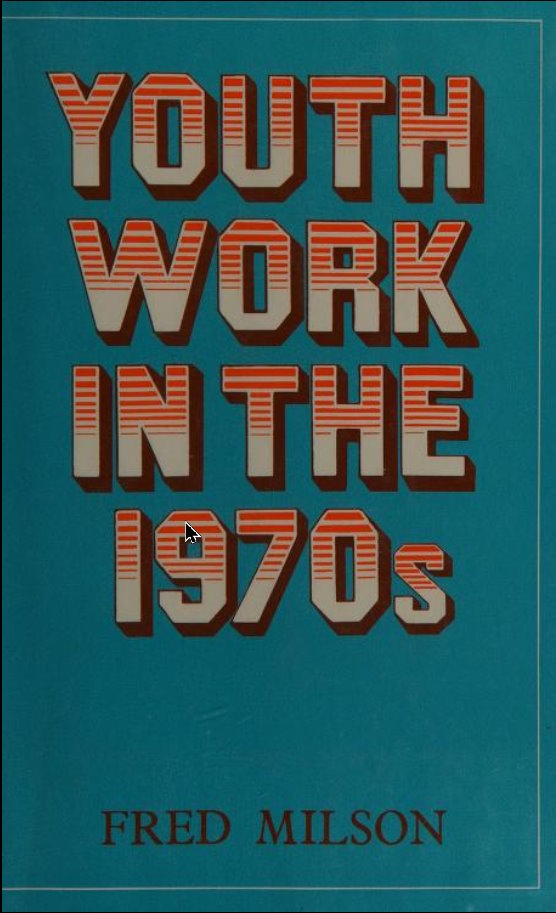
This contribution has to be set in the context of a significant expansion in writing and reflection upon the youth work field and ‘a service intent on professionalizing itself’ (Davies 1999: 76). One question that emerges from this is the extent to which he unwittingly or consciously contributed to a shift from volunteerism to professionalism, and, more worryingly from a concern with calling and vocation to a more bureaucratic and self-seeking orientation. Fred Milson addressed the first of these areas, to some extent, in Youth Work in the 1970s (Milson 1970a: 95-100). He began from the position that youth work would ‘continue to lean on “spare-time” help’ and as a result would need ‘a cadre of professional workers’ (1970a: 96). He noted the uncertainties around the role and argued for the need to rethink the role of the full-time youth worker. He suggested that the youth worker’s skills laid in five areas:
Administrative or managerial. He often has to run an organization.
Group work. He is centrally concerned to help young people to help themselves.
Counselling. Though this word covers different levels of skill and service, yet all will be called upon to give advice to individuals.
Education. He has to stimulate interests and supply and further the interests they have.
Community development. He seeks to relate the work he is doing to the community around and to encourage the discovery and use of the community’s own resources. (Milson 1970a: 99)
Milson had recognized some of the implications of the movements of which he had been a part. It is likely that he would have been appalled at the thought that he may have contributed to a movement away from vocation. He looked to the new cadre of professional workers to display dedication, courage, integrity, confidence and maturity. Some obvious growing points were identified for workers:
- They could learn to interpret the word ‘professional’ not in terms of the status or prestige of their job, or their conditions of work – but as applying to the way in which they do their work: ‘professional standards’ is what is indicated.
- They could learn to respect what they find even though they are properly full of new ideas: some continuity must be preserved: some of the old foundations are in good condition and can be used for the new structure.
- They could learn to work in a harmonious and non-servile way with the older people concerned with their job: the youth leader who can ‘only get on with young people’ is a menace.
- They could understand that a large part of their duty is the communication of their professional skills to part-timers; of course, ‘know-alls’ are out, but a full-time worker, though biding his time, knows that he is a ‘trainer’ of those for whom youth work is only a spare-time occupation. (Milson 1970a: 100)
To some extent, we can fall into the trap of criticizing Milson’s position with the benefit of hindsight. There was a significant deepening of the critique of professionalization in the early 1970s – especially under the influence of writers like Ivan Illich. However, it is possible to argue, given the fears expressed within the service at the time about the impact of growing numbers of professionally trained full-time workers, that Milson was rather optimistic about the direction things would take. He did not have a strong grasp of the social and political forces that conditioned the development of a ‘professional cadre’ of workers within youth work – and the direction these would take workers and the work.
Political education
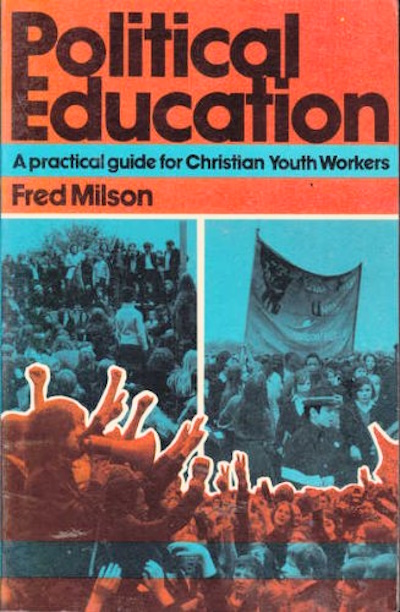
Youth and Community Work in the 70s (DES 1969) made some important and pioneering statements about the role of political education within youth work. ‘If our oft-repeated hope for the new service – ‘the critical involvement of young people in their society’ – is to find any fulfilment then we cannot be isolated from political issues nor political youth groups, for in so doing we would be avoiding some of the major issues of our time’ (DES 1969: 81). Fred Milson continued with this theme in several articles (notably for the Politics Association and their championing of the notion of ‘political literacy’ 1980b). In 1980 he produced Political Education. A practical guide for Christian youth workers. This book looked to the church and politics and the distinctive role that it could take in the political education of young people.
A local church which tries to ignore the political dimension of our lives serves its members ill. It issues moral exhortations in a vacuum. Churches may generate a power which is always in neutral gear, never engaged with some of the major moral tasks our time. To change the figure – they involve us in shadow boxing, not in a real fight.
It looks a more hopeful strategy to devote our main efforts to the political education of the young. One is driven to the conclusion that the pietistic and individualistic attitudes of many older Christians are so deeply entrenched, that it is doubtful they will be changed. Treacherous perhaps, but one is tempted to repeat the question that Nicodemus asked “But how is it possible for a man to born when he is old?” (John 3:4) (Milson 1980a: 33-4)
Fred Milson argued that the informal atmosphere of the small voluntary group, common in Christian youth work, could be a good vehicle for political as well as other forms of education (Milson 1980a: 53). In this, he appeared to be looking to the benefits and experiences of associational life (which had been articulated for youth work in the Albemarle Report – but which Fred Milson had earlier sought to refocus around ‘participation’ – Milson 1970: 39). Another important aspect for Milson was the extent to which the church youth group embodied a more holistic view of people – the political could be set in tension with the moral and spiritual, for example. The book provided church workers with plenty of practical advice. ‘For the Christian political educator’, Milson wrote, ‘there are always growth points in a continuing group’. He continued:
If our essential task is to learn together what the world is really like, to see it in a Christian perspective and to have opportunities to engage in its political activities – then there is a place to begin engaging in this process. It may be a conversation, a new experience in life of the young person, a visit, a chance encounter. The beginnings may be humble and the process should never be forced. But for the discerning Christian worker the raw material of his trade is all around him in the youth group (Milson 1980a: 115)
Fred Milson also made a case for political education in Coming of Age (1979) – but the perspective he adopted could be located in what might be described as a ‘civics tradition’. While there was still a concern with participation – the major interest seemed to be in developing an understanding of, commitment to, and ability to use the existing political system (Smith 1987b: 78. See, also, Smith 1987a). He seemed to grow more cautious around more action-based approaches. Indeed, by the end of the 1970s, he was worried by what he saw as a leftward shift in key areas of youth work. Fred Milson concluded that the radicals, whom he labelled as Marxist, ‘had gone too far in their espousal of “politically aware” innovation and “activism” and that by concentrating on the “distant goal” they had been “diverted from seeking out present opportunities”‘ (quoted by Davies 1999: 192).
Conclusion
Fred Milson was a significant presence on the youth work scene. He was able to make a robust case for the continuing significance of church-based work – and to introduce some important developments in practice especially around social group work and, to some extent, community development. In the broader youth work sphere, he will be remembered for his contribution to the development of training for full-time workers and for encouraging people to see youth in the context of community. He was, perhaps, over-optimistic about the ability of youth workers to resist the logic of professionalization as they became more firmly located within bureaucratic systems and agencies. Whilst they were part of a social, religious or political movement there were crucial counterbalances to bureaucratic convenience and caution, and to narrow policy-driven agendas.
We can place Fred Milson in a long line of Methodist champions of youth work. The list includes Jimmy Butterworth (the founder of Clubland), Bryan Reed and Leonard Barnett and the more radical concerns of Emmeline Pethick. In the forty or so years since his death, there have been profound changes within the church and its work. The church itself has around one-third of the membership it had in 1980 – a similar decline can be seen in Catholicism. Attendance at Anglican churches has more than halved (Faith Survey 2015, 2024). The overall church membership profile has aged (Brierley 2000: 37-8). This has had a major impact on the capacity of churches to undertake and prioritize youth work. Combined with a more general drift away from the club and open work within youth work, and changing attitudes to volunteering, the result has been pressure on many of the defining elements of Methodist practice. That said, Fred Milson’s message concerning the educative power of groups, the need to understand young people in the context of community, and the role of Christian educators remains as relevant today as when he was alive.
Further reading and references
Milson, Frederick W. (1963). Social Group Method and Christian Education. London: Chester House. Provides a clear statement of the significance of social group work within Christian education – and gives plenty of practical guidance.
Milson, Frederick W. (1968). Growing with the job: youth worker’s progress. London: National Association of Youth Clubs. 15 pages. Engaging pamphlet on professional development. Click to download a copy from the infed archive.
Milson, Frederick W. (1970a). Youth work in the 1970s. London: Routledge and Kegan Paul. xiii + 141 pages. Includes a brief history of youth work, an overview of the then-contemporary developments and Milson’s views on areas for development. Click to borrow from the Internet Archive.
Bibliography
Brierley, P. (2000). The Tide is Running Out. What the English Church Attendance Survey reveals. London: Christian Research.
Bulman, Inga, Craft, Maurice and Milson, Frederick W. (eds.) (1970). Youth service and interprofessional studies. Oxford: Pergamon Press.
Davies, B. (1999). From Voluntaryism to Welfare State. A history of the Youth Service in England Volume 1: 1939-1979. Leicester: Youth Work Press.
Department of Education and Science (1969). Youth and Community Work in the 70s. Proposals by the Youth Service Development Council (The ‘Fairbairn-Milson Report’). London: HMSO. Various chapters can be found in the archives.
Etzioni, A. (1968). The Active Society. A theory of societal and political processes. New York: Free Press.
Faith Survey (2015, 2024). Christianity in the UK. Measuring the Christian population in the UK. [https://faithsurvey.co.uk/uk-christianity.html. Retrieved June 3, 2024].
Green, C. (1986). In the Service of Youth. A history of the National Council for Voluntary Youth Services. Leicester: National Council for Voluntary Youth Services.
Holmes, J. (2001). ‘Youth and Community Work in the 1970s. A lost opportunity?’ in R. Gilchrist, T. Jeffs and J. Spence (eds.) Essays in the History of Community and Youth Work. Leicester: Youth Work Press.
Holmes, J. (2009). The Rise and Fall of Community and Youth Work Courses at Westhill College in Ruth Gilchrist, Tony Jeffs, Jean Spence, and Joyce Walker (eds.) Essays in the history of youth and community work: discovering the past. Lyme Regis: Russell House Publishing.
Milson, Frederick W. (1958). The understanding of adolescents in some English Free Churches, 1939-1955, Thesis (M.A.) — University of Leeds (Department of Social Studies),
Milson, Frederick W. (1963). Social Group Method and Christian Education. London: Chester House.
Milson, Frederick W. (1965). Group methods for Christian leaders: a study of group dynamicsl Wallington: Religious Education Press.
Milson, Frederick W. (1968). Growing with the job: youth worker’s progress. London: National Association of Youth Clubs.
Milson, Frederick W. (1970a). Youth work in the 1970s. London: Routledge and Kegan Paul.
Milson, Frederick W. (1970b). Church, youth and community development. London: Chester House. 27 pages.
Milson, Frederick W. (1972). Youth in a changing society. London: Routledge and Kegan Paul.
Milson, Frederick W. (1972a) Why am I a youth worker? : an examination of the goals and motives of youth workers, London: National Association of Youth Clubs.
Milson, Frederick W. (1973). An introduction to group work skill. London: Routledge & Kegan Paul.
Milson, Frederick W. (1974). An introduction to community work. London: Routledge and Kegan Paul.
Milson, Frederick W. (1975). Community work and the Christian faith. London: Hodder and Stoughton, 1975. 105 +iv pages.
Milson, Frederick W. (1979). Coming of Age. Present opportunities for voluntary youth organizations. Leicester: National Youth Bureau.
Milson, Frederick W. (1980a). Political education: A practical guide for Christian youth workers. Exeter: Paternoster Press.
Milson, Frederick W. (1980b). ‘Political education in the British youth service: a short history’, Teaching Politics 9(1): 12-21.
Milson, Frederick W. (1981). Youth in the local church. Leicester: National Youth Bureau.
Milson, Fred W. and Parr, John (1966). The coloured teenager in Birmingham. Birmingham: Westhill College of Education
Ministry of Education (1960). The Youth Service in England and Wales (‘The Albemarle Report’). London, HMSO.
Methodist Council (2010). Report of the Wesley College Review Group. London: The Methodist Church. [https://media.methodist.org.uk/media/documents/coun-full-wesley-college-review-080410_nJbWj6U.pdf. Retrieved June 2, 2024].
Smith, M. (1987a). Political Education. Developing approaches in the community. Youth and Policy Occasional Paper 4. Newcastle: Youth and Policy 1987. [https://markksmith.net/wp-content/uploads/2023/01/Political-Education.-Developing-Mark-Smith.pdf. Retrieved June 2, 2024].
Smith, M. (1987b). ‘Non-formal education with young people’ in C. Harber (ed.) Political Education in Britain, Lewes: Taylor and Francis.
Links
Youth and Community Work in the 70s – the Fairbairn-Milson Report
To cite this article: Smith, M. K. and Doyle, M. E. (2003) (updated by Smith in 2024). ‘Fred Milson: developing the practice of youth and community work’, The encyclopedia of pedagogy and informal education. [https://infed.org/mobi/fred-milson-developing-the-practice-of-youth-and-community-work/. Retrieved: insert date].
Note: The section entitled ‘Life’ was added to the article in 2024. Birth, death, marriage and census data were also checked and updated. Some minor changes were made to the rest of the text. MKS (June 2024).
© Mark K. Smith and Michele Erina Doyle 2003, 2024
